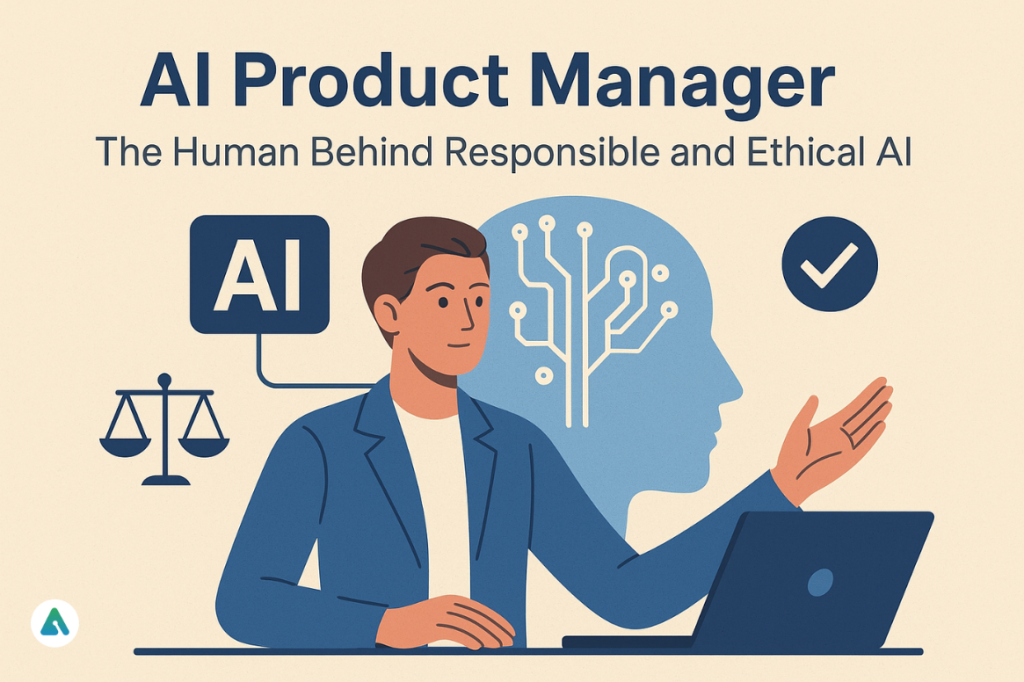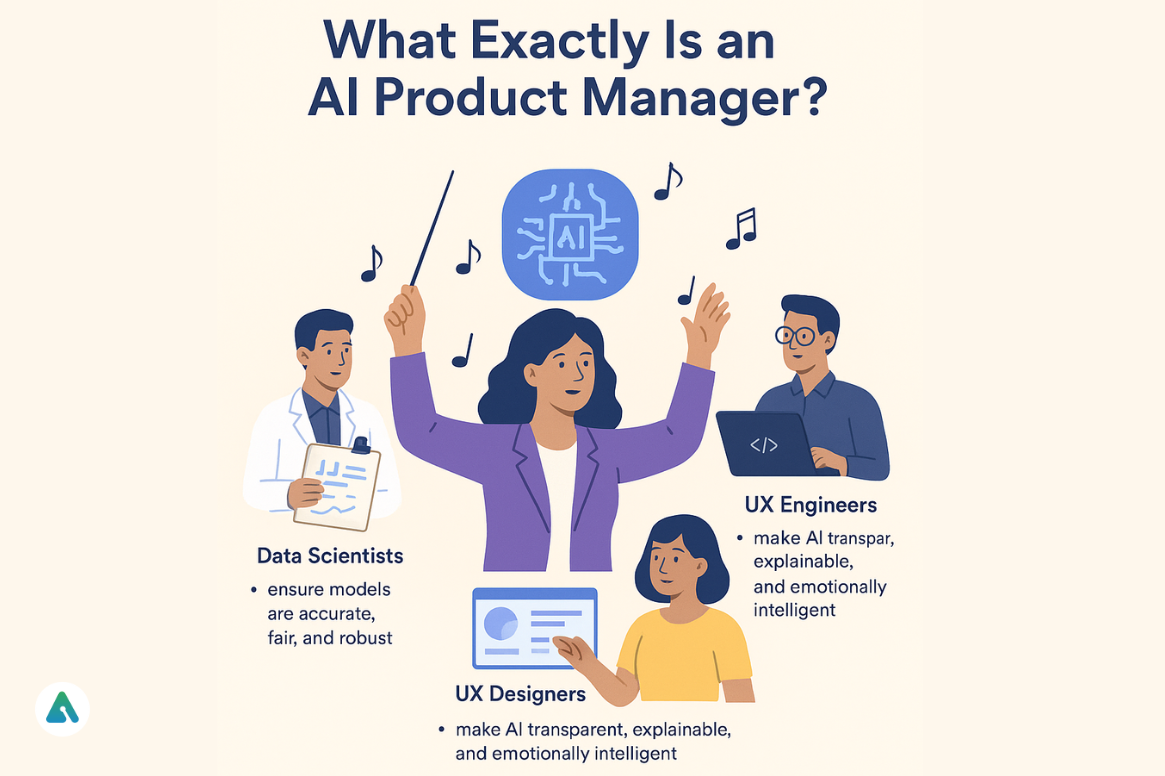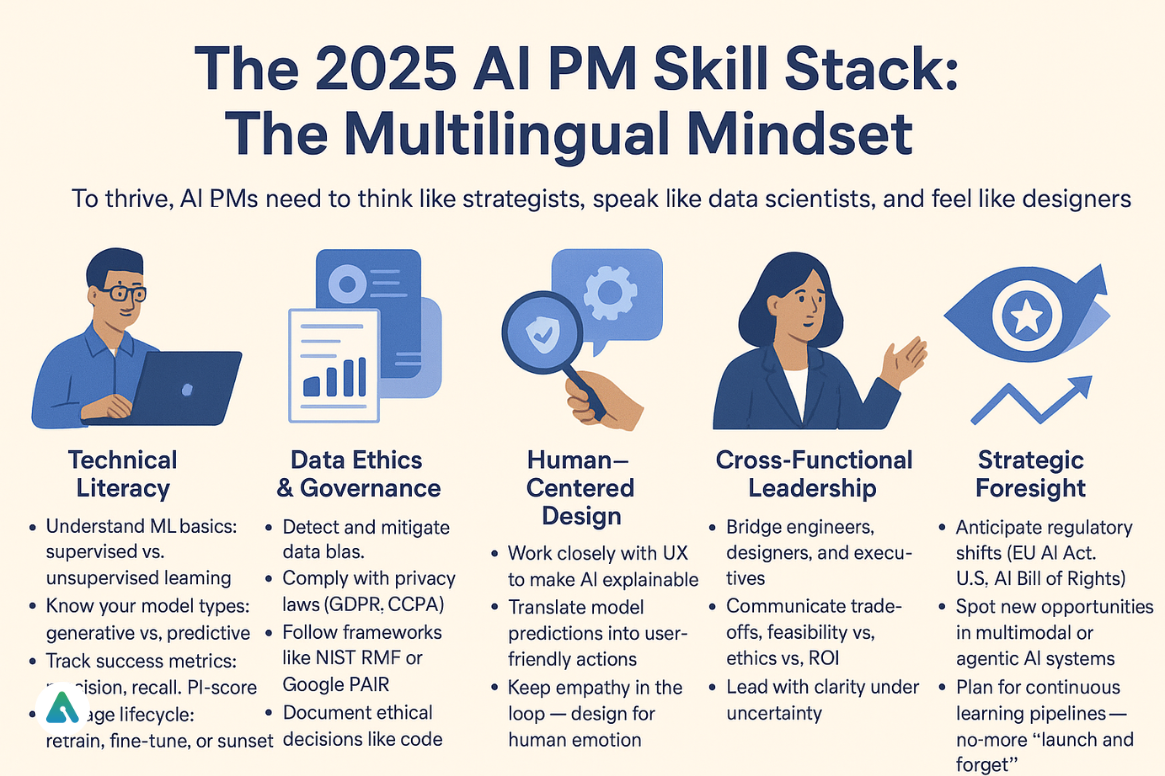Your Spotify playlists know when you’re in your “sad song” phase. Notion drafts your emails before you finish your coffee. Even Google Docs finishes your sentences before you do.
But behind all that wizardry isn’t just a data scientist in a hoodie.
It’s a new kind of product leader: the AI Product Manager (AI PM) — the human guiding the machine.
Unlike traditional PMs, who focus on features, roadmaps, and deadlines, AI PMs live at the edge of uncertainty, where machine learning meets human behavior. Their job isn’t to push code faster — it’s to teach intelligence how to act responsibly, ethically, and usefully.
They’re the people asking the questions no algorithm can:
- “Should we build this AI feature?” not just “Can we?”
- “Will this model help or harm the humans using it?”
What Exactly Is an AI Product Manager?
Think of the AI PM as the conductor of a human-machine orchestra.
They lead the vision, development, and lifecycle of AI-powered products — translating technical brilliance into human benefit.
They collaborate with:
- Data Scientists – to ensure models are accurate, fair, and robust
- ML Engineers – to turn algorithms into usable, scalable features
- UX Designers – to make AI transparent, explainable, and emotionally intelligent
“The AI PM’s superpower isn’t knowing every algorithm — it’s knowing which human problem the algorithm should solve.”
Core Responsibilities
- Define the product vision for AI-enabled experiences
- Set success metrics in collaboration with data teams
- Translate technical potential into business and ethical value
- Manage the AI lifecycle (training, monitoring, retraining, retiring)
- Advocate for fairness, transparency, and responsible AI practices
E-E-A-T: The New Core of AI Product Management
In 2025, AI systems quietly shape billions of micro-decisions — what we see, buy, read, and even trust.
That’s why E-E-A-T (Experience, Expertise, Authoritativeness, Trustworthiness) isn’t just SEO jargon. It’s the moral code of AI Product Management.
| Principle | In SEO | In AI Product Management |
| Experience | Write from firsthand understanding | Apply real-world learnings to model design and validation |
| Expertise | Show technical accuracy | Understand ML limits, bias, and trade-offs |
| Authoritativeness | Cite credible sources | Align with frameworks like Google PAIR or ISO 42001 |
| Trustworthiness | Build reader confidence | Build user trust through explainability and ethical decisions |
When your product literally learns from people, credibility isn’t optional — it’s oxygen.
AI PMs have to show their “workings” the same way scientists do, because trust is the new UX.
A Day in the Life: Two Real AI PMs
Let’s make it real.
Elara, an AI PM at a digital health startup:
- 8:30 AM: Reviews model drift reports — the disease-risk predictor is showing bias toward older patients. She flags a retraining review.
- 10:00 AM: Meets with engineers, UX, and compliance to design transparent risk-score visualizations for clinicians.
- 1:00 PM: Over lunch, reads the latest EU AI Act updates to anticipate regulatory changes.
- 3:00 PM: Runs an A/B test comparing AI recommendations to clinician-validated results.
- 5:30 PM: Presents to leadership — not just on ROI, but on fairness and interpretability.
Every hour, Riya balances business value, ethics, and human impact — the modern AI PM’s “triangle of truth.”
Now meet Kael, an AI PM at a fintech startup:
- 9:00 AM: The fraud detection model flags too many legitimate transactions in a new region.
- 10:30 AM: Debates trade-offs: tighten the model and block real users, or loosen it and risk fraud?
- 2:00 PM: Simulates retraining outcomes, aiming for a 12% drop in false positives.
- 4:00 PM: Documents ethical rationale — how this decision protects users and
As the ProdPad blog describes, AI PMs are emerging as ‘ethical gatekeepers’ — humans ensuring machine logic aligns with human values.
The 2025 AI PM Skill Stack: The Multilingual Mindset
To thrive, AI PMs need to think like strategists, speak like data scientists, and feel like designers.
1. Technical Literacy
- Understand ML basics: supervised vs. unsupervised learning
- Know your model types: generative vs. predictive
- Track success metrics: precision, recall, F1-score
- Manage lifecycle: retrain, fine-tune, or sunset
2. Data Ethics & Governance
- Detect and mitigate data bias
- Comply with privacy laws (GDPR, CCPA)
- Follow frameworks like NIST RMF or Google PAIR
- Document ethical decisions like code commits
3. Human-Centered Design
- Work closely with UX to make AI explainable
- Translate model predictions into user-friendly actions
- Keep empathy in the loop — design for human emotion
4. Cross-Functional Leadership
- Bridge engineers, designers, and executives
- Communicate trade-offs: feasibility vs. ethics vs. ROI
- Lead with clarity under uncertainty
5. Strategic Foresight
- Anticipate regulatory shifts (EU AI Act, U.S. AI Bill of Rights)
- Spot new opportunities in multimodal or agentic AI systems
- Plan for continuous learning pipelines — no more “launch and forget”
Becoming an AI Product Manager
The best part? There’s no single path here. Many AI PMs come from product, data, UX, or even marketing. What matters most is curiosity and adaptability.
Step 1: Learn the Fundamentals
Start with beginner-friendly certifications:
- IBM AI Product Manager Certificate – great intro to ML thinking
- Microsoft AI PM Certificate – ties directly to Azure ML workflows
- Udacity AI Product Management Nanodegree – project-based
- Product School: AI for PMs – concise and career-focused
Step 2: Build Small, Real Projects
Recruiters don’t want buzzwords — they want proof of thought.
Create mini-projects like:
- GPT-powered ideation assistants
- Bias detection dashboards
- AI recommendation modules for dummy apps
Case in point: Lena, a former marketing PM, built a simple NLP chatbot to summarize survey data. She documented design trade-offs and landed a health-tech PM job six months later.
Step 3: Master Business Storytelling
AI literacy means little if you can’t explain it to decision-makers.
Your goal: turn model metrics into stories about human impact.
Step 4: Apply with Strategy
Search for roles like AI Product Manager, Machine Learning PM, or Data Product Lead.
Quantify your results — “Improved recommendation accuracy by 12% post-bias mitigation” speaks louder than buzzwords.
Market Trends, Salaries & Industries (2025 Snapshot)
| Region | Average Salary (USD) |
| U.S. & Canada | $130K–$185K |
| UK & EU | £85K–£120K |
| India / APAC | $70K–$100K |
| Remote | $100K–$160K |
Top Industries: SaaS, Fintech, Healthcare, EdTech, and increasingly ClimateTech.
Real-World Case Studies
Netflix – Personalization without Echo Chambers
Algorithms predict taste profiles, but AI PMs balance serendipity and diversity to prevent monotony.
Duolingo – Adaptive Learning Acceleration
AI PMs tune NLP models to detect frustration or motivation, personalizing lessons on the fly.
Stripe – Fraud Detection at Scale
PMs balance precision and recall — keeping transactions secure without frustrating real users.
Babylon Health – Diagnostic Transparency
Human-in-the-loop design ensures clinicians understand how AI reaches its predictions, preserving trust.
These aren’t data stories — they’re human-impact stories powered by data.
Certifications That Actually Matter (2025 Edition)
| Program | Level | Why It Matters |
| IBM AI Product Manager | Beginner | Widely recognized, strong fundamentals |
| Microsoft AI PM | Intermediate | Integrates Azure & Responsible AI toolkit |
| Udacity Nanodegree | Advanced | Portfolio-driven, hands-on ML projects |
| Product School AI for PMs | Practical | Short, job-ready format |
| Univ. of Washington AI PM | Academic | Theory + ethics emphasis |
Can AI Replace Product Managers?
Not yet — and probably never fully.
AI can write specs, generate roadmaps, and even summarize user research. But it can’t handle ambiguity, empathy, ethics, or the critical thinking needed to make nuanced decisions.
“AI can predict behavior — but only humans can define values.”
AI PMs remain the conscience of intelligent systems. They decide when automation crosses the line, when personalization turns invasive, and when optimization becomes biased.
The Future: 2025–2030 Trends
- AI Copilots for PMs – Generative copilots help draft user stories, run analyses, and brainstorm features.
- Multimodal Products – Text, voice, and image blend into unified experiences (think ChatGPT-Vision-powered apps).
- Continuous Learning Pipelines – Models retrain in real time, requiring PMs to manage AI observability.
- Regulation & Trust – EU AI Act and U.S. AI Bill of Rights enforce explainability by design.
- Agentic AI Systems – PMs guide semi-autonomous agents, ensuring alignment with human goals.
FAQs
Q1. What does an AI Product Manager do?
An AI Product Manager (AI PM) defines the AI strategy, aligns data science projects with business goals, and ensures the ethical deployment of AI models. They act as the bridge between technical teams, stakeholders, and end-users to create AI products that are reliable, responsible, and scalable.
Q2. Do AI PMs need to know how to code?
Not necessarily. While coding is not mandatory, understanding data pipelines, machine learning metrics, and AI behavior is crucial. This knowledge helps PMs make informed decisions, evaluate model performance, and communicate effectively with engineers and data scientists.
Q3. Are AI PMs in demand?
Yes. The demand for AI product managers has grown rapidly — LinkedIn’s 2025 Jobs Report notes a 120% increase since 2023. Organizations across tech, healthcare, finance, and e-commerce increasingly rely on AI PMs to drive responsible AI adoption.
Q4. What skills do AI PMs need?
Top skills include:
- Data literacy – understanding AI models and analytics
- Ethics & AI governance – ensuring fair and responsible AI
- Storytelling & communication – translating technical concepts for stakeholders
- Cross-functional leadership – collaborating with engineering, design, and business teams
Q5. How can AI PMs demonstrate E-E-A-T?
AI PMs can showcase their Expertise, Experience, Authoritativeness, and Trustworthiness by:
- Publishing detailed AI case studies
- Sharing lessons learned from real-world AI projects
- Quantifying impact on fairness, accuracy, and business outcomes
- Participating in AI ethics forums or thought leadership platforms
The Real Meaning: Humans Who Guide Machines
Being an AI Product Manager isn’t about building smarter algorithms — it’s about building wiser systems.
You’re not just managing features; you’re managing consequences.
You’re teaching machines to think, but more importantly, to respect.
“If you can balance logic with empathy, data with judgment, and AI with ethics — congratulations. You’re already leading the future.”
Visit: AIInsightsNews




